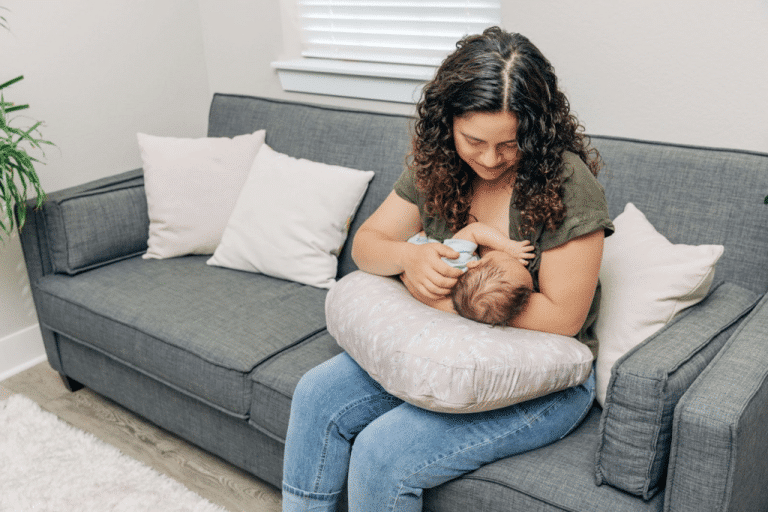Every parent knows the frustration of putting their baby to bed only to have them wake up 30 minutes later, wide-eyed and ready to play.
False start bedtimes can turn a peaceful evening into an exhausting battle, leaving both parents and babies frustrated and sleep-deprived.
But here’s the good news: false starts are common and, more importantly, they’re manageable. In this guide,
I’ll walk you through the reasons behind false starts, share practical strategies to prevent them, and help you understand your baby’s sleep patterns.
Whether you’re dealing with a newborn or an older infant, you’ll explore actionable tips to create smoother, more restful bedtimes for your little one.
What is a False Start Bedtime?
A false start bedtime is a term used to describe a situation where a child initially seems to settle down and go to sleep but then experiences difficulties falling or staying asleep shortly after being put to bed.
It often involves a scenario where the child may appear calm and ready for sleep at the beginning of the bedtime routine, only to get up, cry, or become fussy shortly afterward.
This can create a prolonged and frustrating bedtime experience for both the child and their parents.
False starts can disrupt the typical nighttime routine, leading to more attempts to get the child to sleep and, in some cases, causing sleep deprivation for both the child and caregivers.
False start bedtimes are a relatively common occurrence, especially in younger children, and can stem from various causes.
Understanding why false starts happen and how to manage them is essential for maintaining a healthy sleep routine.
Reasons Behind False-Start Bedtime
There are several reasons why false start bedtimes happen, often related to the developmental stage of the baby, sleep patterns, and environmental or physical factors, which are as follows
1. Overtiredness and Sleep Pressure
When babies become overtired, their bodies enter a state of physiological stress, triggering the release of cortisol and adrenaline.
These stress hormones act as stimulants, making it extremely difficult for babies to achieve and maintain deep sleep.
Signs of overtiredness include eye-rubbing, increased fussiness, and hyperactivity.
The “second wind” phenomenon occurs when these hormones kick in, causing babies to appear energetic despite exhaustion.
2. Incorrect Sleep Schedule Timing
Babies operate on biological sleep waves that are governed by their age-specific wake windows and circadian rhythms.
When bedtime falls outside their natural sleep pressure window, their bodies aren’t physiologically ready for sustained sleep.
For instance, a 6-month-old typically needs 2-3 hours of wake time before bedtime.
Putting them to bed too early might result in a “nap” rather than night sleep, while too late can trigger overtiredness.
3. Digestive System Discomfort
Babies with reflux or gas issues often struggle to stay asleep during their initial sleep phase.
The horizontal position can worsen reflux symptoms, causing discomfort that triggers wake-ups. Recent feeding timing, volume, and composition play crucial roles in digestive comfort.
Some babies may also experience food sensitivity reactions that peak during early evening hours, leading to increased fussiness and difficulty maintaining sleep.
4. Physical Development and Motor Activity
Growing bodies experience various physical sensations that can interrupt sleep.
Growth spurts often cause increased hunger and physical discomfort. Teething pain typically intensifies during evening hours when other distractions decrease.
Emerging gross motor skills create physical restlessness as babies’ bodies process new movement patterns.
The development of muscle strength and coordination can cause involuntary movements or twitches that disturb initial sleep.
Comprehensive Solutions for Conquering False Start Bedtimes
At the apex of our solution pyramid lies a fundamental truth: false start bedtimes are not a permanent challenge, but a solvable puzzle unique to each baby’s developmental journey.
1. Establish an Age-Appropriate Sleep Schedule
- Calculate optimal wake windows: 1.5-2 hours for newborns, 2-3 hours for 3-6 months, 3-4 hours for 6-12 months
- Adjust nap lengths and timing seasonally to account for changing daylight patterns
- Implement a “sweet spot” bedtime between 7:00-8:00 PM when cortisol levels naturally dip.
- Create buffer zones around sleep times to prevent rushing or overstimulation
- Consider developmental leaps and growth spurts when adjusting schedules.
2. Design a Consistent Bedtime Routine
- Begin the wind-down process 45-60 minutes before intended sleep time
- Structure routine in order of decreasing activity: bath → massage → feeding → books → songs → sleep
- Incorporate calming sensory elements: gentle touch, soft lighting, soothing scents, quiet voices
- Use verbal and physical cues to signal transitions between activities
- Keep routine length consistent: 20-30 minutes for younger babies, 30-45 minutes for older infants
3. Optimize the Sleep Environment
- Maintain room temperature between 68-72°F (20-22°C) with 50-60% humidity
- Layer lighting: blackout curtains + dim red night light for feeds
- Use continuous white noise at 50-60 decibels, placed 5-7 feet from baby
- Ensure proper ventilation with air circulation but no direct drafts
- Choose breathable, natural fiber bedding and sleep clothing
4. Manage Physical Comfort and Biological Needs
- Time last feeding to end 20-30 minutes before sleep time
- Position for optimal digestion based on any reflux or gas issues
- Select sleep clothing appropriate for room temperature: TOG ratings 0.5-2.5
- Address teething discomfort with appropriate pain management if needed
- Consider growth spurt timing and adjust feeding patterns accordingly
Do Babies Grow Out of False Starts?
Yes, babies generally grow out of false start bedtimes as they get older.
In the early stages of life, babies experience frequent sleep disruptions due to their developing sleep cycles, circadian rhythms, and physical discomforts such as hunger, teething, or growth spurts.
As they mature, their sleep cycles become longer and more consistent, making it easier for them to stay asleep once they’ve been put to bed.
Additionally, babies start to develop better self-soothing skills, which allow them to return to sleep on their own if they wake up.
A consistent bedtime routine also plays a key role, as it helps signal to the baby that it’s time for sleep.
As babies move past these early stages and their developmental milestones, stabilize, false starts typically decrease, and their sleep patterns become more predictable.
Developmental Stages and False Start Progression
| Age Range | False Start Characteristics | Typical Duration | Developmental Markers |
|---|---|---|---|
| 0-3 months | Frequent, unpredictable | Most common | Circadian rhythm formation |
| 3-6 months | Gradually decreasing | Moderate occurrence | Sleep cycle consolidation |
| 6-12 months | Sporadic | Diminishing frequency | Independent sleep skill development |
| 12-18 months | Rare | Minimal | Advanced self-soothing capabilities |
Wrapping Up!
False start bedtimes are a common challenge for many parents, especially during periods of growth and development.
While they can be frustrating, understanding the causes and implementing strategies like adjusting wake windows, creating a calming bedtime routine, and ensuring a comfortable sleep environment can help reduce their occurrence.
Consistency is key in helping your baby transition into a restful sleep, and with patience, false starts typically resolve on their own.
Remember, each baby is unique, and finding the right balance between routine, environment, and sleep needs will ultimately lead to more peaceful nights for both you and your little one.
Frequently Asked Questions
Is False Start Bedtime Common?
Yes, false start bedtimes are relatively common, especially in younger babies. As babies develop and their sleep patterns mature, false starts typically become less frequent.
Should I Pick My Baby up When They Wake After a False Start?
It depends. If your baby is crying, comforting them can help settle them back to sleep. However, if they seem content or just fussing, giving them a few minutes to self-soothe might encourage them to fall back asleep on their own.
When Should I Consult a Pediatrician About False Start Bedtimes?
If false starts persist for weeks or if they are accompanied by other signs like excessive crying, discomfort, or health issues (e.g., fever, ear infections), it may be worth consulting a pediatrician to rule out any underlying health concerns.












